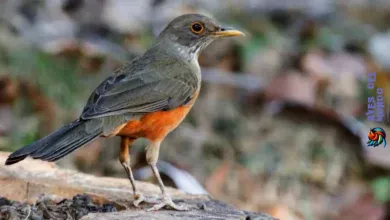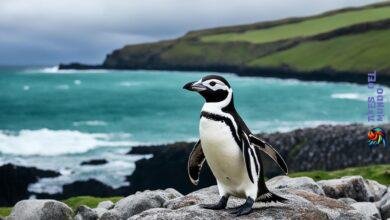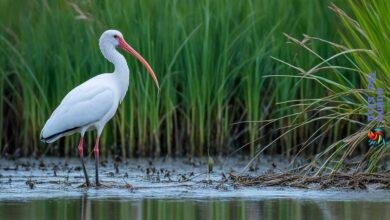Have you ever wondered about penguins living in freezing Antarctica? Meet the Adelie penguin. It’s a species that thrives in the harsh South Pole. This small bird has remarkable ways to adapt and survive.
But here’s something to think about: How do these seabirds not just survive, but also do well in such an extreme place?
Let’s explore the world of the Adelie penguin. We’ll learn about its home, how it acts, and more. By the end, you’ll see how special this species is. You’ll also understand the challenges it faces as the world changes.
Adelie Penguin: Distribution and Abundance
Adelie penguins are one of five species found in Antarctica. They live all along the Antarctic coast and on small islands. You can see these birds near Australian research stations, where they are a big part of the wildlife.
In the Windmill Islands near Casey, there’s been a huge increase in Adelie penguins. In the 1950s, there were about 30,000 breeding pairs. Now, there are nearly 200,000 pairs. This makes this place the third largest Adelie penguin spot in East Antarctica.
There’s also a smaller group of Adelie penguins on Béchervaise Island near Mawson. This colony has around 1,800 breeding pairs. Both locations show how common Adelie penguins are in Antarctica.
Adelie penguins are great swimmers too. They can swim more than 1,200 km away from their homes. This shows they are good at finding new places and surviving in the cold Antarctic waters.
Distribution of Adelie Penguins
| Location | Number of Breeding Pairs |
|---|---|
| Windmill Islands (near Casey) | Nearly 200,000 |
| Béchervaise Island (near Mawson) | Approximately 1,800 |
Adelie Penguin: Breeding and Behavior
Adelie penguins have an interesting breeding cycle and unique behaviors. They breed from October to February. This time is best for their survival in Antarctica. They make nests from pebbles on ice-free areas and lay two eggs.
Their eggs incubate for about 35 days. Parents take turns keeping the eggs warm and finding food. This teamwork helps keep the eggs safe and supports breeding success.
After the eggs hatch, parents feed their chicks by regurgitating food. They bring back fish, krill, and small crustaceans. This provides the chicks with the nutrients they need to grow.
The chicks grow fast, gaining about 80 grams daily. At 3 weeks old, parents leave them in groups. This is for protection and warmth during food hunts. It teaches the chicks how to survive and prepare for adult life.
In February, the chicks start to molt. They shed their fluffy feathers for adult ones. By 7 to 9 weeks old, with new feathers, they’re ready to go to sea. They follow their parents’ path.
The way Adelie penguins breed and act can vary by location and environment. But their care for their young and their breeding habits are constant across the species.
Adelie Penguin Breeding and Behavior in Pictures
| An Adelie penguin incubating its eggs | A young Adelie penguin chick accompanied by its parent |
Adelie Penguin: Diet and Feeding Habits
Adelie penguins live in the Antarctic and eat various foods like krill, fish, and small crustaceans. Their diet changes depending on where they are and how close they are to other penguins.
Near their colony, within 20 km, they mostly eat fish, amphipods, and crystal krill. These foods are crucial for feeding their chicks.
When they journey farther from shore, they mainly eat Antarctic krill. This ensures their chicks get enough food.
Penguins feed their chicks meals weighing between 300 to 650 grams. To find food, parents swim far, from 5 to 120 km away. These trips can take up to 72 hours.
Adelie penguins’ eating habits are essential for their survival and the Antarctic’s health. By eating krill and fish, they help keep the ecosystem in balance. This supports the food chain, including predators like leopard seals and killer whales.
Feeding Habits Summary
| Feeding Habits | Meal Composition | Distance Range | Duration |
|---|---|---|---|
| Local Meals (within 20 km of the colony) | Fish, amphipods, and crystal krill (Euphausia crystallorophias) | N/A | N/A |
| Offshore Meals | Antarctic krill (Euphausia superba) | 5 to 120 km | 5 to 72 hours |
Adelie penguins are unique because they have special ways to find food in their cold home. Protecting these penguins and their feeding areas keeps the Antarctic balanced.
Adelie Penguin: Conservation Status
Adelie penguins thrive in the Antarctic’s extreme cold. They’re currently seen as not at-risk on the IUCN Red List. Yet, climate change poses a big threat. In some areas, their numbers dropped by more than 65% in 25 years. This shows why protecting these penguins is urgent.
These penguins depend on sea ice for life. But, climate change is upsetting their home. Warm temperatures and melting ice threaten their survival. It’s crucial we act now to save them.
Saving Adelie penguins helps more than just them. It keeps the Antarctic ecosystem healthy. They’re key in the food web. Protecting them helps other animals too, like krill.
Climate change affects all wildlife in Antarctica, not just Adelie penguins. Their decline is a wakeup call. By supporting green efforts and conservation, we can fight climate change. This will help save the Adelie penguins and our planet.
The Impact of Climate Change on Adelie Penguins
«Climate change is pushing Adelie penguins to the brink of extinction. Rising temperatures and melting ice disrupt their delicate ecosystems, threatening their survival. It’s up to us to make a difference and protect these magnificent creatures and the Antarctic environment.»
| Threats to Adelie Penguins | Conservation Actions |
|---|---|
| Loss of sea ice habitat due to melting ice | Supporting initiatives to reduce greenhouse gas emissions |
| Disruption of food sources, such as krill | Establishing protected areas and marine reserves |
| Extreme weather events and increased predation | Collaborating with local communities and governments to regulate human activities in the Antarctic |
| Tourism impacts and disturbance | Raising awareness and promoting responsible tourism practices |
Adelie Penguin: Importance in the Antarctic Ecosystem
Adelie penguins are vital for the Antarctic ecosystem’s health. They feed on small creatures like krill and fish. This makes them key food for predators such as leopard seals and killer whales.
Their survival is crucial for the ecosystem’s balance. They help keep food sources available for many species. This balance supports the unique biodiversity of this cold place.
The Role of Adelie Penguins in the Food Chain
Adelie penguins are a central part of the Antarctic food chain. They connect the dots from phytoplankton to larger animals. Their diet helps control the number of krill and fish, keeping the ecosystem stable.
While feeding, they also spread nutrients on land. Their droppings enrich the soil, helping algae and bacteria grow. This nourishes a wide range of life forms.
Conserving Adelie Penguins for a Healthy Ecosystem
It’s key to protect Adelie penguins for the ecosystem’s sake. Climate change and ice loss threaten them and the balance of life. Safeguarding their home helps other species too.
Efforts to protect them include less human disturbance and fighting climate change. By cutting carbon emissions and adopting green practices, we can help penguins and their environment.

| Adelie Penguin’s Role in the Antarctic Ecosystem | Importance |
|---|---|
| Contribution to the food chain as prey species | Essential for predators’ survival |
| Regulation of prey population | Maintains balance in the ecosystem |
| Fertilization of land through excrement | Supports growth of algae and bacteria |
| Indicator species for environmental changes | Alerts researchers to ecosystem health |
Adelie Penguin: Threats and Conservation Efforts
Climate change is a big threat to Adelie penguins. It harms their home and food sources. The loss of sea ice due to higher temperatures messes up their breeding places and ecosystem. Also, changing ocean currents impact the food and nutrients they need to survive.
Overfishing makes things tougher for Adelie penguins. Being major predators in the Antarctic, less fish means less food for them and their chicks. Also, people’s activities like tourism and research can mess up their nesting sites and stress them out.
To help Adelie penguins, there are big efforts in place. Scientists and groups study these penguins closely. They track their breeding success, what they eat, and any changes in their home. By knowing the best breeding spots, they can protect these important areas.
There’s also a push to teach people about Adelie penguins’ role in the Antarctic. Through education and outreach, we learn how climate change and fishing hurt these penguins. Everyone’s help is key in keeping these unique animals safe.
| Threats | Conservation Efforts |
|---|---|
| Climate Change | Monitoring and studying populations |
| Overfishing | Identifying key breeding sites |
| Human Disturbance | Raising awareness and education |
We must protect Adelie penguins and their world for a healthy Antarctic ecosystem. By working together and backing conservation, we can fight the threats they face. This ensures future generations can enjoy these amazing Antarctic birds.
Adelie Penguin: Research and Monitoring
Scientists play a key role in saving Adelie penguins. They study these Antarctic birds by observing them over time. Places like the Windmill Islands are important for this research.
They use cameras, satellite tracking, and other tools for their work. This helps understand how climate change affects these birds.
Knowing about their breeding and travel patterns helps create conservation plans. Research helps figure out how to keep Adelie penguins safe.
Research Methods and Techniques
Field work lets scientists watch Adelie penguins live. They check on breeding, count populations, and study nests. This approach offers deep insights into penguin life.
Automatic cameras record penguin behavior without bothering them. These cameras show how they feed and care for their young. The footage gives a close look at their daily routines.
Satellite tracking tracks penguins’ movements. It shows where they go to find food and how they adapt. This information is crucial for understanding them better.
«Studying Adelie penguins teaches us how to protect them,» says Dr. Emma Johnson. This knowledge helps ensure they thrive.
Data Analysis and Conservation Strategies
Researchers look at the data to find patterns and threats. They study how climate change impacts penguins. This helps gauge the health of the species.
This leads to strong plans to save the penguins. It guides efforts to tackle threats and protect their home. Research adapts to new challenges over time.
The Importance of Collaboration
Working together is key for saving Adelie penguins. Scientists, groups, and governments must join forces. This way, they can plan and share knowledge.
Getting communities and groups involved is also vital. It creates a joint effort to protect these unique birds and their habitat.
Adelie Penguin: Partnerships and Future Conservation Initiatives
Many groups are working together to save Adelie penguins and their homes. They team up with local people, those who bring tourists, and science experts. Together, they make plans that can keep the penguins safe for years to come.
These groups are trying to lessen the dangers from climate change. This big problem threatens the penguins and where they live. By cutting down on harmful gases and protecting their icy environments, we can help.
It’s also important to reduce human footprints and promote careful tourism near the penguins. Teaching visitors and applying rules can protect these birds and their homes. This way, everyone helps in saving this special Antarctic area.
Working together is key to saving the Adelie penguins. By building strong partnerships and using new ways to protect them, their future is brighter. These amazing penguins will continue to amaze and inspire people everywhere.



